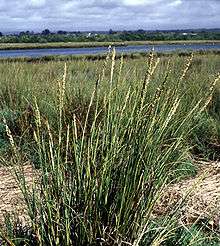Spartina
| Spartina | |
|---|---|
 | |
| S. densiflora | |
| Scientific classification | |
| Kingdom: | Plantae |
| (unranked): | Angiosperms |
| (unranked): | Monocots |
| (unranked): | Commelinids |
| Order: | Poales |
| Family: | Poaceae |
| Subfamily: | Chloridoideae |
| Tribe: | Zoysieae |
| Genus: | Spartina Schreb.[1] |
| Type species | |
| Spartina cynosuroides (L.) Roth. | |
| Synonyms[2] | |
| |
Spartina, commonly known as cordgrass or cord-grass,[3] is a genus of plants in the grass family, frequently found in coastal salt marshes.[4]
The genus name is derived from σπαρτίνη (spartiné), the Greek word for a cord made from Spanish broom (Spartium junceum).[5] They are native to the coasts of the Atlantic Ocean in western and southern Europe, northwest and southern Africa, the Americas and the southern Atlantic Ocean islands; one or two species also occur on the North American Pacific Ocean coast and in freshwater habitats inland in the Americas. The highest species diversity is on the east coasts of North and South America, particularly Florida.
They form large, often dense colonies, particularly on coastal salt marshes, and grow quickly. The species vary in size from 0.3–2 m tall. Many of the species will produce hybrids if they come into contact.
- Spartina alterniflora Loisel. – Smooth Cordgrass - Atlantic coasts of North + South America, West Indies
- Spartina anglica C.E.Hubb. – Common Cordgrass - Great Britain; introduced scattered other places
- Spartina arundinacea (Thouars) Carmich - Tristan da Cunha, Amsterdam Island in Indian Ocean
- Spartina bakeri Merr. – Sand Cordgrass - southeastern USA
- Spartina × caespitosa A.A.Eaton – Short Cordgrass - eastern USA + Canada (PEI to VA)
- Spartina ciliata Brongn. - Brazil, Argentina, Uruguay
- Spartina cynosuroides (L.) Roth – Big Cordgrass - eastern USA (TX to MA); Tamaulipas, Chihuahua, Bahamas
- Spartina densiflora Brongn. – Denseflower Cordgrass - Venezuela, Brazil, Argentina, Uruguay, Chile
- Spartina foliosa Trin. – California Cordgrass - California, Baja California, Baja California Sur
- Spartina gracilis Trin. – Alkali Cordgrass - western Canada, western + central USA, Chihuahua, Jalisco, Michoacán
- Spartina longispica Hauman & Parodi ex St.-Yves - Argentina, Uruguay
- Spartina maritima (Curtis) Fernald – Small Cordgrass - Great Britain, Netherlands, Belgium, France, Spain, Portugal, Italy, Croatia, Morocco, Mauritania, Namibia, South Africa
- Spartina patens (Aiton) Muhl – Saltmeadow Cordgrass - east coast of North America from Labrador to Tamaulipas; West Indies
- Spartina pectinata Bosc ex Link – Prairie Cordgrass from Northwest Territories to Texas + Newfoundland
- Spartina spartinae (Trin.) Merr. ex Hitchc. – Gulf Cordgrass - Atlanic coast of North America from Florida to Argentina, incl Caribbean + Gulf of Mexico
- Spartina × townsendii H.Groves & J.Groves (S. alterniflora × S. maritima) – Townsend's Cordgrass - western Europe
- Spartina versicolor Fabre - Mediterranean, Azores
- formerly included[2]
see Bouteloua Crypsis Dactylis Digitaria
- Spartina geniculata - Dactylis geniculata
- Spartina glabriuscula - Digitaria radicosa
- Spartina humilis - Bouteloua chondrosioides
- Spartina phleoides - Crypsis schoenoides
- Spartina pubera - Digitaria ciliaris
- Spartina schoenoides - Crypsis schoenoides
Cultivation
Spartina has been planted by humans to reclaim estuarine areas for stripping, to supply fodder for livestock, and to prevent erosion. Various members of the genus (especially Spartina alterniflora and its derivatives, Spartina anglica and Spartina × townsendii) have spread outside of their native boundaries and become invasive.
Big Cordgrass (S. cynosuroides) is used in the construction of bull's eye targets for sports archery. A properly constructed Spartina target can stop an arrow safely without damage to the arrowhead as it lodges in the target.[9]
Ecology
Spartina species are used as food plants by the larvae of some Lepidoptera species including Aaron's Skipper (which feeds exclusively on Smooth Cordgrass) and Engrailed.
As an invasive species
Three of the Spartina species have become invasive plants in some countries. In British Columbia, Spartina anglica, also known as English Cordgrass, is an aggressive, aquatic alien that invades mud flats, salt marshes and beaches, out-competing native plants, spreading quickly over mud flats and leaving large Spartina meadows.[10]
See also
- Sand Bay - an area in the UK where Spartina grass planted to support a river bank has spread.
- Invasive grasses of North America
References
- ↑ "Genus: Spartina Schreb.". Germplasm Resources Information Network. United States Department of Agriculture. 2011-02-27. Retrieved 2011-03-03.
- 1 2 3 Kew World Checklist of Selected Plant Families
- 1 2 "Spartina". Integrated Taxonomic Information System. Retrieved 2011-03-03.
- ↑ Schreber, Johann Christian Daniel von. 1789. Genera Plantarum Eorumque Characteres Naturales Secundum Numerum, Figuram, Situm, & Proportionem Omnium Fructificationis Partium. (Ed. 8[a]). 43
- ↑ Barkworth, Mary E. "17.45 SPARTINA Schreb.". Intermountain Herbarium. Utah State University. Retrieved 2013-11-30.
- ↑ The Plant List search for Spartina
- ↑ "GRIN Species Records of Spartina". Germplasm Resources Information Network. United States Department of Agriculture. Retrieved 2011-02-25.
- ↑ Biota of North America Program 2013 county distribution maps
- ↑ "Bull's-eye Builder". Popular Mechanics. June 1952. pp. 126–127.
- ↑ Spartina, Aliens Among Us.
External links
| Wikimedia Commons has media related to Spartina. |
| Wikispecies has information related to: Spartina |
- Spartina anglica: species derivation and problems
- San Francisco Estuary Invasive Spartina Project: Maps and Findings
- Spartina information from the University of Florida
- Invasive Spartina in Willapa Bay
- USDA: Spartina